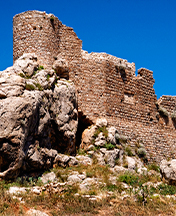The history of Kalymnos is parallel to the history of the other Dodecanese islands. Kalymnos has been inhabited since pre-Minoan times. During the Archaic period, the distance of the Dodecanese from Athens gave autonomy to these islands, including Kalymnos, and freedom from imperial Athens. With the rise of the Macedonian Empire, Kalymnos, as well as the other islands of the complex, joined it. After the death of Alexander the Great, one of his successors, PtolemyI of Egypt, took control of all the islands of the Dodecanese. During the Early Byzantine Period, Kalymnos flourished, but from the 7th century AD, the invaders took advantage of its vulnerable strategic position. In the 14th century, the Knights Hospitaller ruled Kalymnos, as did all the Dodecanese, and built Chrysocheria Castle on the island to protect it. In 1522 the Ottoman occupation followed and ended in 1912, with the arrival of the Italians. When the Italians surrendered, the Germans and the English fought to take control of the islands of the Dodecanese, causing great damage and suffering to the population. Kalymnos joined the newly built Greek state with the rest of the Dodecanese in 1947. In the 1960s, the economy of Kalymnos, based on sponge fishing, gradually began to decline and many of its inhabitants emigrated.











